Tesla's Robotaxi Gamble: A Game-Changing Leap or Overvalued Mirage?
The launch of Tesla's robotaxi service in Austin on June 22, 2025, marks a pivotal moment for the company's autonomous ambitions. Elon Musk has long positioned Full Self-Driving (FSD) as Tesla's next revenue engine, but skepticism abounds. With competitors like Waymo already dominating the autonomous ride-hailing market and regulatory hurdles looming, the question remains: Does this trial represent a transformative leap or an overhyped gamble with material risks? Let's dissect the evidence.

FSD Beta's Progress and Pitfalls
Tesla's FSD v13.2.9 update, deployed in June 2025, highlights incremental improvements:
- Technical Advances: 36Hz video processing, reduced latency by 50%, and enhanced collision avoidance algorithms.
- Beta Limitations: Requires constant driver supervision, lacks “Start from Park” functionality on Cybertrucks, and has not yet solved urban complexity (e.g., multi-lane roundabouts).
The system's safety record remains under scrutiny. A would reveal stock dips coinciding with safety probes. For instance, Tesla's shares fell 8% in early 2025 after the NHTSA launched a probe into over 50 crashes involving FSD-equipped vehicles.
Musk's Timeline Accuracy: A History of Missed Promises
Elon Musk's track record on autonomous timelines is fraught with delays:
- 2019: Predicted 1 million robotaxis by 2020 → Failed.
- 2020: Claimed Level 5 autonomy by 2021 → Failed.
- 2025: Promised unsupervised FSD by Q2 2025 → Postponed to 2026.
to visualize the gap between vision and execution. Current crowdsourced data shows FSD averages 493 miles between critical disengagements—far from the 670,000-mile benchmark
itself set for unsupervised driving.Competitor Benchmarks: Waymo's Dominance vs. Tesla's Struggle
Waymo's 250,000 weekly rides in Q1 2025 dwarf Tesla's modest Austin trial (initially 10–20 vehicles). Key contrasts:
- Safety: Waymo's sixth-gen driver has a 3.5x better safety record than humans (Swiss Re analysis). Tesla's FSD lacks third-party validation.
- Deployment: Waymo operates in 5 U.S. cities with plans to expand; Tesla's rollout is geofenced and requires regulatory approvals.
- Valuation: Waymo's $45 billion valuation (vs. Tesla's $500+ billion) reflects skepticism about Tesla's autonomous roadmap.
. The data paints a stark picture: Tesla trails in both scale and credibility.
Regulatory and Financial Risks
- Safety and Compliance:
- The NHTSA's unresolved probe and Texas' delayed teleoperation approval (required for remote driver support) create legal risks.
Tesla's refusal to share teleoperation protocols contrasts with Waymo's transparency, raising trust issues.
Stock Valuation Concerns:
- Tesla's forward P/S ratio (10.69) is nearly 4x the auto industry average. Analysts like Goldman Sachs cite a $235 price target, down from $300, due to subsidy losses and competitive pressure.
A shows a potential 50% profit drop.
Market Competition:
- BYD's Q1 2025 deliveries (416,388 vs. Tesla's 336,681) highlight Tesla's eroding EV dominance. Waymo's ride-hailing lead adds pressure.
The Investment Dilemma
Bulls argue:
- Robotaxis could generate $100+ billion annually by 2030.
- Tesla's cost advantage ($50k vehicles vs. Waymo's $180k) could scale rapidly.
Bears counter:
- Overvaluation: Tesla's stock trades at 185x forward P/E, nearly double its five-year average.
- Execution risks: Musk's timeline credibility and unresolved safety issues.
- Regulatory headwinds: NHTSA's scrutiny and California's permitting delays.
Investment Recommendation
Tesla's robotaxi trial is a critical test, but the odds favor caution. While the technology shows promise, systemic risks—regulatory, competitive, and valuation-related—outweigh near-term upside.
Hold with reservations: Wait for FSD's unsupervised launch (2026) and clearer safety data before reconsidering.
Sell if valuation contraction continues: If Tesla's P/S ratio falls to industry norms, shares could plummet 40–50%.
. The data suggests Tesla's stock is pricing in success already—a high bar to clear without major breakthroughs.
Final Verdict: Tesla's robotaxi gamble is a high-risk, long-shot bet. Investors should prioritize capital preservation unless Musk delivers on safety, scalability, and regulatory compliance—sooner rather than later.

Comments
No comments yet